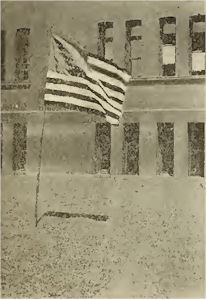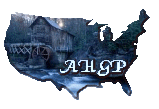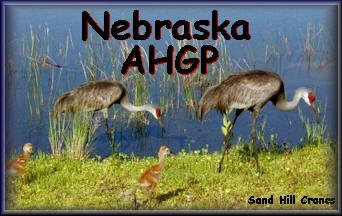Base Hospital 49
 |
A Visit to the University of
Nebraska Hospital Overseas
Incidents of Hospital Work at
Allereye
Return of the Unit to
Nebraska
Best Record for Saving Life
in A. E. F |
| Nurses'
Flag of Base Hospital 49 |
Officers
Enlisted
Personnel
Nursing
Personnel
Civilians
On December 7, 1918, I was upon a French railway express train
en route from Paris, by way of Dijon, for the American hospital
center at Allereye and particularly for Base Hospital 49, the
Nebraska representative among the hospital units in Europe.
Allereye is a little French village of perhaps 400 people, about
150 miles southeast of Paris and 40 miles from the frontier of
Switzerland. Upon the slightly rolling, partly wooded, plain
adjoining the village the U. S. army engineers had laid out a
great hospital center covering about eighty acres of ground. Ten
hospital units were in this center, seven of them regular army
hospitals, one from the University of Minnesota, one from the
University of Cincinnati and one from the University of
Nebraska. Special railroad tracks had been made running through
the heart of the camp. Twenty thousand beds were included in the
plans for this center.
It was July, 1918, when this was done. The air was filled with
rumors of a great movement by the American army against the
German lines. The various hospital units were hurried to this
center. Doctors, hospital attendants and nurses worked night and
day making drainage ditches, building hospital huts, installing
beds and laboratories, setting in order all the appliances and
instruments for modern hospital work. No one knew how soon the
camp would be flooded with the trainloads of broken and maimed
American boys from the battle front.
It was August 7th when the men of Nebraska base hospital arrived
at Allereye. The first wounded men arrived August 26. A great
concentration of American divisions was already forward. This
was the preparation for the St. Mihiel drive, which took place
September 12-14. On September 14 the nurses, 100 in number,
belonging to the Nebraska unit, arrived at Allereye. It had been
estimated that it might cost 60,000 in killed and wounded to
capture the St. Mihiel salient. But the American artillery so
thoroughly deluged the German trenches with shell fire that the
actual losses to the American army were less than one-fourth the
estimates.
Meanwhile the great attack in the Argonne Forest and along the
Meuse north of Verdun went forward. Here the losses were greater
than expected. The Allereye hospital center was so situated that
it received more wounded men during the Argonne battle than any
other of the American hospitals. Altogether there were received
here over 40,000 casualties. Of these 4,844 were cared for in
the Nebraska unit, the highest number of cases at any one time
being 1.934. As the unit was intended to furnish beds for 1,000
patients, the extent of its overcrowding may be surmised.
The day I arrived at Allereye there were about 1,100 cases in
the hospital. It was three weeks after the last trainload of
wounded had reached the center. The next morning was Sunday. At
the invitation of Major Stokes I accompanied him on a four hours
inspection of all the wards in the Nebraska unit. The memories
of that morning will always be among the most vivid of the war.
In scores of cases I saw the wounds dressed. Many of these men
were so torn with frightful lacerating projectiles that it
seemed impossible for them to survive. Yet nearly all of them
were hopeful and clear-eyed. Almost all made recovery.
The ingenious devices of the surgeons to hold together a
shattered human being while nature restored the broken bones,
recreated the tissues and knit together the mangled flesh,
commanded my continuous admiration. A soldier's arm had been
broken by a shell in two or three places, both legs were
shattered, several ribs fractured, much of his flesh reduced to
pulp. Yet there he was, three weeks after he had been picked up
at the front, swinging in a kind of cat's cradle which took all
the weight from the broken bones and tissues, smiling and
smoking a cigarette while the nurse carefully and tenderly
removed the old dressings and supplied new ones. It was the aim
of the Nebraska surgeons to save the limb if possible. In dozens
of cases men went out of the Nebraska hospital, homeward, on two
legs, where a first examination seemed to indicate amputation
necessary. I remember one man in particular who had fought a
month's battle inside the hospital to save his leg. His skin was
clear, his eye bright and his voice cheerful. He had won the
victory with the help of the hospital.
Along the line of the Meuse a month before I had seen the waste
and the wreck of war, dead soldiers and horses scattered over
the field, broken trucks and caissons, wounded men in ambulances
going to the rear. Here was the salvage station. The men and
women of the hospital corps constituted the redemption arm of
the military service. No heroism or sacrifice of war times
seemed to me so worthy of highest praise as that of the hospital
corps.
Colonel J. H. Ford, commander of the Allereye center, said to me
when I called upon him Monday: "The people of Nebraska may
justly be proud of Base Hospital Unit 49. The official report
just out shows that it has the lowest percentage of mortality of
any hospital unit in the American army."
Sunday afternoon, December 8, we had a Nebraska rally in the Red
Cross hall. Major Stokes presided. Most of what was said was
about Nebraska. No one can know without experience how far away
home seems in a foreign land, particularly when you are under
orders and do not know how long the homeward bound order may be
delayed. So a tender sentiment pervaded the meeting and the
handclasps were warm, for the hearts were full.
The O. P. L. Club
I was invited to a smoker held by the O. P. L. Club. I had no
more idea what the O. P. L. Club was than a rabbit with its eyes
shut, but I found out. It was a live wire organization.
Translated its initials meant "Order of Permanent Lieutenants,'
and it held frequent celebrations over the significance of its
name. All the members were young doctors having the rank of
lieutenant. Most of them had hoped to become captains or majors
or something while in the military service. All of them had
bumped up against headquarters and realized there were no
further prospects for their ambitions. So they organized the
order of the O. P. L. They had a class song. It was a mile long,
but two stanzas will suffice:
Oh, we went in as lootenants in the A-ar-my,
And we'll go out as lootenants from the A-ar-my.
Majors they wanted to make us all.
But we refused to heed the call,
For all we wanted was just to work, that's all.
That's all, etc.
So we are simply members of the O. P. L.
Just flunkeys and ward-surgeons at the 'ospitell,
We play about, we sing and shout,
'We carry the pan and duck about.
And we all rejoice 'cause we like it here so well.
Like Hell, etc.
The badge of the O. P. L. was a lead cross made from bullets cut
from the quivering flesh of American boys shot down at the front
and brought to Base Hospital 49. It was fastened by a ribbon to
the coat. Just how many members of the O. P. L. are now wearing
this decoration in America I am unable to state. Here is the
complete roster of the O. P. L. at the time I was at Allereye:
| Lieutenants |
Fred W. Webster
Geo. W. Covey
Robt. Panter
J. E. M. Thomson
E. W. Park
H. E. Flansburg
John S. Simms
Geo. M. Boehler
J. W. MacDonald |
F. W. Campbell
E. Delaney
Miles J. Breuer
W. R. Peters
Sanford R. Gifford
Theodore Shaffer
E. W. Buckley
W. L. Sucha
A. Greenberg |
The class song, class yell and other material relating to the O.
P. L. are treasured relics in the State Historical Society
rooms. There was a nurses' dinner and reception in the evening
to the commanding officer, staff and the Nebraska visitor. One
of the finest experiences a man ever gets in this life is in
observation of the army hospital nurse. (War and fighting death
in the hospital transform a woman. Handling the broken flesh of
soldiers stirs depths in her nature never revealed in the
ordinary walks. So I shall never think of the Nebraska women I
saw in Base Hospital 49 in any other way than with a kind of
mediaeval reverence, such as the old painters put into the
pictures of the women they painted upon the cathedral walls of
Europe.
On the third day of my visit I said good bye to Allereye. I had
bunked with Captain (Dean) Tancock and Major Hull. I had been
presented the freedom of their apartments by Captain Rowe and
Captain Potts. I had shaken hands with every high private I met.
In the camp; for everyone had "Nebraska" in his heart and on his
lips. Tender and strong are the cords which bind us to our home.
The farther we wander the closer they bind us together. And, as
I write, these memories of the "Little Nebraska" at Allereye
seem among the best inspirations of a Nebraska lifetime.
Many of Base Hospital 49 are at home. Soon all will be. Off come
the Khaki uniforms and Red Cross costumes. Back into the busy
ranks of civil life.
Historians were appointed overseas for Base Hospital 49. They
have a theme worthy of their best efforts. For in the history of
Nebraska in the World War no chapter will be of more enduring
interest than the story of the service of Base Hospital 49.

Base Hospital 49
A. P. O. 785, American E. F.,
15 January, 1919
Mr. Addison E. Sheldon,
State Historical Society
Lincoln, Nebraska.
Dear Sir: Herewith enclosed you will find a list of Base
Hospital No. 49 personnel, with the names of their home cities,
as per your request of December 20, 1918, written from Paris.
A. C. Stokes, Major M. C.
Nebraska AHGP

Source: Nebraska History and Record of Pioneer Days, Volume I,
Number 1, Published Monthly by the Nebraska Historical Society,
February 1918.
Nebraska Links

Hosted Free |
 |
Please stop by again!!
Copyright August © 2011 -
AHGP The American History and Genealogy Project.
Enjoy the work of our webmasters, provide a link, do not copy their work.
|
![]()

![]()